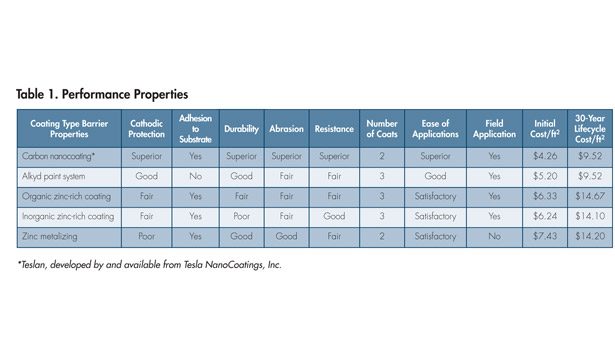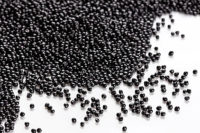History is filled with coatings. It’s not clear why prehistoric painters covered their cave walls with animal images, but today we cover surfaces with paint and other coatings for both protection and decorations. As a result, the chemistry of coatings has continuously evolved. Today, numerous basic formulation options consist of oil, alkyd, latex, epoxy and others. Beyond that, there are an unlimited range of color and finish options.
| Jump to: |
Most recently, a significant new development in coatings has emerged, a technology that incorporates carbon nanotubes (CNTs) as part of the base formulation. In a variety of initial applications, this emerging coating chemistry has shown promise as a potent, yet affordable, weapon in corrosion prevention.
Nanotechnology
Nanotechnology refers to the manipulation of matter on an atomic scale. The carbon nanotubes used as a coating component are tubular structures consisting entirely of carbon atoms. CNTs are the strongest materials ever discovered, with tensile strengths as high as 50 times that of steel. They also display remarkable thermal and electrical conductance, with conductivity 1,000 times greater than copper.
Nanotechnology has enabled a whole new class of composite structural materials that are both light and strong. They are also found in everything from carbon-fiber tennis rackets to the composite materials used in commercial and military aircraft.
When included as a coating component, CNTs provide multiple benefits and overcome many of the most common shortcomings of current coatings. In fact, the strength imparted by CNTs improves both durability and abrasion resistance. And the enhanced tensile strength and flexibility, combined with greater thermal conductance, enables the coating to flex as the substrate thermally shrinks and expands. This also creates a stronger bond between coating and substrate. Taken together, these traits extend coating life. In addition, compared to conventional coatings that rely on heavy zinc loading in the base coating to prevent corrosion, CNTs provided an added level of anti-corrosion by conducting electricity more effectively.
Less is More
Current zinc-based anti-corrosion coatings require a three-layer system. The first is the zinc-rich primer. An unfortunate trait of zinc, however, is that it is brittle and intolerant of heat-related expansion and contraction. Hence the need for the second, intermediate coating, which supports the zinc primer and helps keep it in place. The third layer provides the color and surface texture.
As mentioned earlier, CNTs dramatically increase both conductivity and flexibility. This eliminates the need for the intermediate coating, reducing the cost, time and effort of application by nearly a third. The CNT-based coatings apply exactly like any other coating, with no special preparation, application or curing. Surface preparation for demonstration projects has thus far followed military specifications for near-white metal. Furthermore, the enhanced bonding traits of the product are also under study for their ability to reduce surface preparation requirements.
“The per-gallon cost of the new material is currently somewhat higher than traditional coatings,” said Joe Barone, Tesla NanoCoatings’ vice president of Sales and Marketing. “When application costs are included in the calculations, the two-coat CNT-based product has a clear cost advantage.”
As with any new technology, there are some concerns about the health and environmental effects of nanotechnology. This includes the inhalation of airborne nanoparticles in production facilities, as well as the transdermal transmission of silver nanoparticles applied to clothes as an antibacterial agent.
“Regarding the CNTs incorporated in the new generation of coatings, the first fact to recall is that they are pure carbon, the chemical basis of all known life,” said Barone. “Once included in a matrix, either in the liquid form or when dried on the surface, the CNTs cannot be inhaled or transferred through the skin. The other components of any liquid coating present a far greater health danger than nanotubes.”
Potential Applications
While CNT-based coatings exhibit a number of benefits over traditional coatings, corrosion resistance is the most significant. It’s not surprising, therefore, that the most promising initial uses are for large steel structures such as bridges, storage tanks, and exterior industrial structures.
Demonstration projects have been conducted at several locations in conjunction with the Army Corps of Engineers, considered the military’s center of expertise for corrosion research. These demonstration projects are showing better-than-expected performance.
Another high-potential application is in the oil and gas industry for both above-ground and down-hole equipment. While demonstration projects of the new coating system have thus far focused on exterior coatings, the product can also be formulated for interior coatings of both drill and transmission piping. The carbon dioxide (CO2) and hydrogen sulfide (H2S) commonly present under high pressures in drill pipe has a highly corrosive effect. Covering the pipe interior with the CNT-based coating would protect the pipe from corrosion, as well as abrasion from sand, grit and other contaminants that are commonly present.
Also being explored is the use of CNT-based coatings to provide electromagnetic shielding. New structural composites are replacing metal in everything from cell phones to jet liners. In the past, the metal provided a shielding effect, protecting humans from the known carcinogenic effects of even low-level electromagnetic radiation. The CNT-based coatings may be used in the future to provide this shielding.
Increasing Acceptance
As with any new technology, there is hesitation to stray from the well-known coating systems. As the positive results from demonstration projects continue to accumulate and people develop a better understanding of the safety and benefits of CNT-based coatings, there’s little doubt there will be greater acceptance and more widespread applications for this new technology.
For additional information, please www.teslanano.com.




